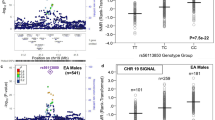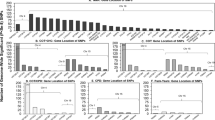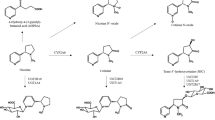Abstract
Cotinine is a proxy for secondhand smoke (SHS) exposure. Genetic variation along nicotine and cotinine metabolic pathways may alter the internal cotinine dose, leading to misinterpretations of exposure-health outcome associations. Caucasian children with available SHS exposure and hair cotinine data were genotyped for metabolism-related genes. SHS-exposed children had 2.4-fold higher hair cotinine (0.14±0.22 ng mg−1) than unexposed children (0.06±0.05 ng mg−1, P<0.001). SHS-exposed children carrying the NAT1 minor allele had twofold higher hair cotinine (0.18 ng mg−1 for heterozygotes and 0.17 ng mg−1 for homozygotes) compared with major allele homozygotes (0.09 ng mg−1, P=0.0009), even after adjustment for SHS dose. These findings support that NAT1 has a role in the metabolic pathway of nicotine/cotinine and/or their metabolites. The increased cotinine levels observed for those carrying the minor allele may lead to SHS exposure misclassification in studies utilizing cotinine as a biomarker. Additional studies are required to identify functional single-nucleotide polymorphism(s) (SNP(s)) in NAT1 and elucidate the biological consequences of the mutation(s).
This is a preview of subscription content, access via your institution
Access options
Subscribe to this journal
Receive 6 print issues and online access
$259.00 per year
only $43.17 per issue
Buy this article
- Purchase on Springer Link
- Instant access to full article PDF
Prices may be subject to local taxes which are calculated during checkout




Similar content being viewed by others
References
ACS. Secondhand Smoke and Children Fact Sheet. American Cancer Society: Atlanta, GA, 2006.
California Environmental Protection Agency. Proposed Identification of Environmental Tobacco Smoke as a Toxic Air Contaminant. Air Resources Board and Office of Environmental Health Hazard Assessment. Sacramento, California, June 2005.
The Health Consequences of Involuntary Exposure to Tobacco Smoke: A Report of the Surgeon General. Department of Health and Human Services (ed). Department of Health and Human Services, Centers for Disease Control and Prevention, Coordinating Center for Health Promotion, National Center for Chronic Disease Prevention and Health Promotion, Office on Smoking and Health: Atlanta, GA, 2006.
Schuster MA, Franke T, Pham CB . Smoking patterns of household members and visitors in homes with children in the United States. Arch Pediatr Adolesc Med 2002; 156: 1094–1100.
Benowitz N . Cotinine as a biomarker of environmental tobacco smoke exposure. Epidemiol Rev 1996; 18: 188–204.
How Tobacco Smoke Causes Disease: The Biology and Behavioral Basis for Smoking-Attributable Disease: A Report of the Surgeon General. Department of Health and Human Services PHS, Office of the Surgeon General (ed): Rockville, MD, USA, p 17, 2010.
Benowitz NL, Jacob P 3rd . Individual differences in nicotine kinetics and metabolism in humans. NIDA Res Monogr 1997; 173: 48–64.
Benowitz NL, Jacob P 3rd . Metabolism of nicotine to cotinine studied by a dual stable isotope method. Clin Pharmacol Ther 1994; 56: 483–493.
Perez-Stable EJ, Herrera B, Jacob P 3rd, Benowitz NL . Nicotine metabolism and intake in black and white smokers. JAMA 1998; 280: 152–156.
Benowitz NL, Perez-Stable EJ, Herrera B, Jacob P 3rd . Slower metabolism and reduced intake of nicotine from cigarette smoking in Chinese-Americans. J Natl Cancer Inst 2002; 94: 108–115.
Benowitz NL, Hukkanen J, Jacob P 3rd . Nicotine chemistry, metabolism, kinetics and biomarkers. Handb Exp Pharmacol 2009; 192: 29–60.
Mwenifumbo JC, Tyndale RF . Molecular genetics of nicotine metabolism. Handb Exp Pharmacol 2009; 192: 235–259.
Hukkanen J, Jacob P 3rd, Benowitz NL . Metabolism and disposition kinetics of nicotine. Pharmacol Rev 2005; 57: 79–115.
Brandange S, Lindblom L . The enzyme "aldehyde oxidase" is an iminium oxidase. Reaction with nicotine delta 1'(5') iminium ion. Biochem Biophys Res Commun 1979; 91: 991–996.
Brandange S, Lindblom L . Synthesis, structure and stability of nicotine delta1'(5') iminium ion, an intermediary metabolite of nicotine. Acta Chem Scand B 1979; 33: 187–191.
Yamazaki H, Inoue K, Hashimoto M, Shimada T . Roles of CYP2A6 and CYP2B6 in nicotine C-oxidation by human liver microsomes. Arch Toxicol 1999; 73: 65–70.
Lang T, Klein K, Fischer J, Nussler AK, Neuhaus P, Hofmann U et al. Extensive genetic polymorphism in the human CYP2B6 gene with impact on expression and function in human liver. Pharmacogenetics 2001; 11: 399–415.
Caporaso NE, Lerman C, Audrain J, Boyd NR, Main D, Issaq HJ et al. Nicotine metabolism and CYP2D6 phenotype in smokers. Cancer Epidemiol Biomarkers Prev 2001; 10: 261–263.
van Vleet T, Bombick D, Coulombe RA Jr . Inhinition of human cytochrome p450 2E1 by nicotine, cotinine and aqueous cigarette tar extract in vivo. Toxicol Sci 2001; 64: 185–191.
Messina ES, Tyndale RF, Sellers EM . A major role for CYP2A6 in nicotine C-oxidation by human liver microsomes. J Pharmacol Exp Ther 1997; 282: 1608–1614.
Nakajima M, Yamamoto T, Nunoya K, Yokoi T, Nagashima K, Inoue K et al. Characterization of CYP2A6 involved in 3'-hydroxylation of cotinine in human liver microsomes. J Pharmacol Exp Ther 1996; 277: 1010–1015.
Malaiyandi V, Goodz SD, Sellers EM, Tyndale RF . CYP2A6 genotype, phenotype, and the use of nicotine metabolites as biomarkers during ad libitum smoking. Cancer Epidemiol Biomarkers Prev 2006; 15: 1812–1819.
Nakajima M, Fukami T, Yamanaka H, Higashi E, Sakai H, Yoshida R et al. Comprehensive evaluation of variability in nicotine metabolism and CYP2A6 polymorphic alleles in four ethnic populations. Clin Pharmacol Ther 2006; 80: 282–297.
Yang M, Kunugita N, Kitagawa K, Kang SH, Coles B, Kadlubar FF et al. Individual differences in urinary cotinine levels in Japanese smokers: relation to genetic polymorphism of drug-metabolizing enzymes. Cancer Epidemiol Biomarkers Prev 2001; 10: 589–593.
LeMasters GK, Wilson K, Levin L, Biagini J, Ryan P, Lockey JE et al. High prevalence of aeroallergen sensitization among infants of atopic parents. J Pediatr 2006; 149: 505–511.
Biagini Myers JM, Khurana Hershey GK, Deka R, Burkle JW, Levin LS, Bernstein DI et al. Asking the right questions to ascertain early childhood secondhand smoke exposures. J Pediatr 2012; 160: 1050–1051.
Eliopoulos C, Klein J, Phan MK, Knie B, Greenwald M, Chitayat D et al. Hair concentrations of nicotine and cotinine in women and their newborn infants. JAMA 1994; 271: 621–623.
Price AL, Patterson NJ, Plenge RM, Weinblatt ME, Shadick NA, Reich D . Principal components analysis corrects for stratification in genome-wide association studies. Nat Genet 2006; 38: 904–909.
Narayanaswamy CR, Raghavarao D . Principal Component Analysis of Large Dispersion Matrices. Appl Stat J Roy St C 1991; 40: 309–316.
Purcell S, Neale B, Todd-Brown K, Thomas L, Ferreira MA, Bender D et al. PLINK: a tool set for whole-genome association and population-based linkage analyses. Am J Hum Genet 2007; 81: 559–575.
Sim E, Walters K, Boukouvala S . Arylamine N-acetyltransferases: from structure to function. Drug Metab Rev 2008; 40: 479–510.
McKennis H Jr, Turnbull LB, Bowman ER . N-Methylation of nicotine ad cotinine in vivo. J Biol Chem 1963; 238: 719–723.
Neurath GB . Aspects of the oxidative metabolism of nicotine. Clin Invest 1994; 72: 190–195.
Neurath GB, Pein FG . Gas chromatographic determination of trans-3'-hydroxycotinine, a major metabolite of nicotine in smokers. J Chromatogr 1987; 415: 400–406.
Swan GE, Benowitz NL, Lessov CN, Jacob P 3rd, Tyndale RF, Wilhelmsen K . Nicotine metabolism: the impact of CYP2A6 on estimates of additive genetic influence. Pharmacogenet Genomics 2005; 15: 115–125.
Keskitalo K, Broms U, Heliovaara M, Ripatti S, Surakka I, Perola M et al. Association of serum cotinine level with a cluster of three nicotinic acetylcholine receptor genes (CHRNA3/CHRNA5/CHRNB4) on chromosome 15. Hum Mol Genet 2009; 18: 4007–4012.
Flegal KM, Brownie C, Haas JD . The effects of exposure misclassification on estimates of relative risk. Am J Epidemiol 1986; 123: 736–751.
Schoedel KA, Hoffmann EB, Rao Y, Sellers EM, Tyndale RF . Ethnic variation in CYP2A6 and association of genetically slow nicotine metabolism and smoking in adult Caucasians. Pharmacogenetics 2004; 14: 615–626.
Kubota T, Nakajima-Taniguchi C, Fukuda T, Funamoto M, Maeda M, Tange E et al. CYP2A6 polymorphisms are associated with nicotine dependence and influence withdrawal symptoms in smoking cessation. Pharmacogenomics J 2006; 6: 115–119.
Acknowledgements
We thank the clinic staff for their efforts in study coordination, recruitment, data management and data collection. We also thank all of the CCAAPS families for their time and commitment. This work was supported by the National Institute for Environmental Health Sciences grants R01-ES011170 and P30-ES006096.
Author information
Authors and Affiliations
Corresponding author
Ethics declarations
Competing interests
The authors declare no conflict of interest.
Rights and permissions
About this article
Cite this article
LeMasters, G., Khurana Hershey, G., Sivaprasad, U. et al. N-acetyltransferase 1 polymorphism increases cotinine levels in Caucasian children exposed to secondhand smoke: the CCAAPS birth cohort. Pharmacogenomics J 15, 189–195 (2015). https://doi.org/10.1038/tpj.2014.44
Received:
Revised:
Accepted:
Published:
Issue Date:
DOI: https://doi.org/10.1038/tpj.2014.44



